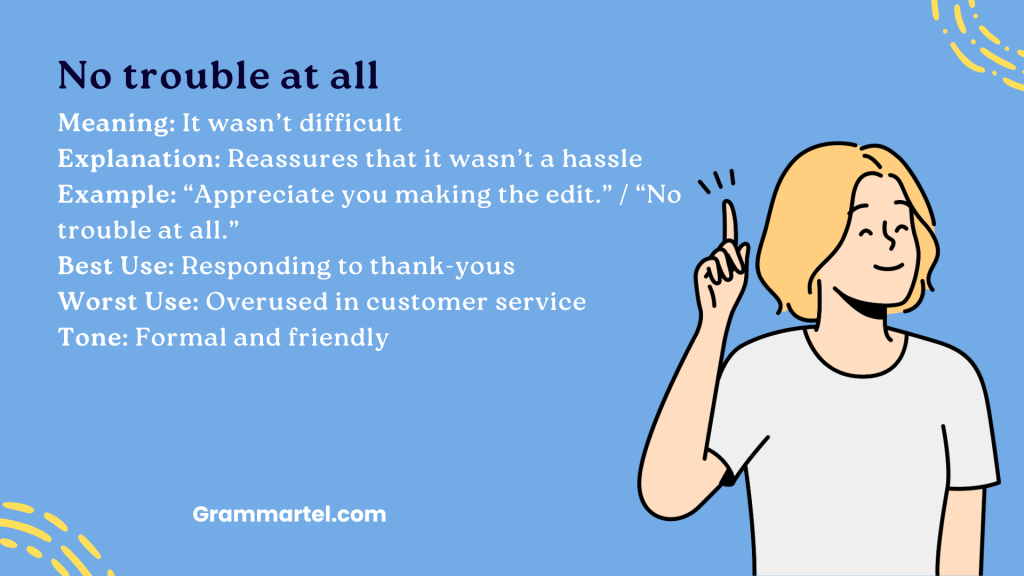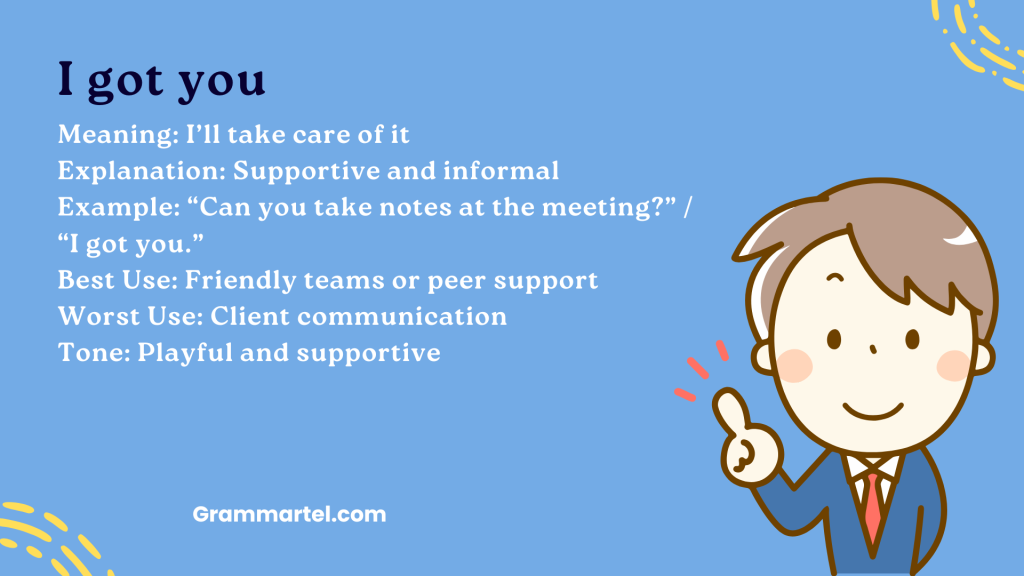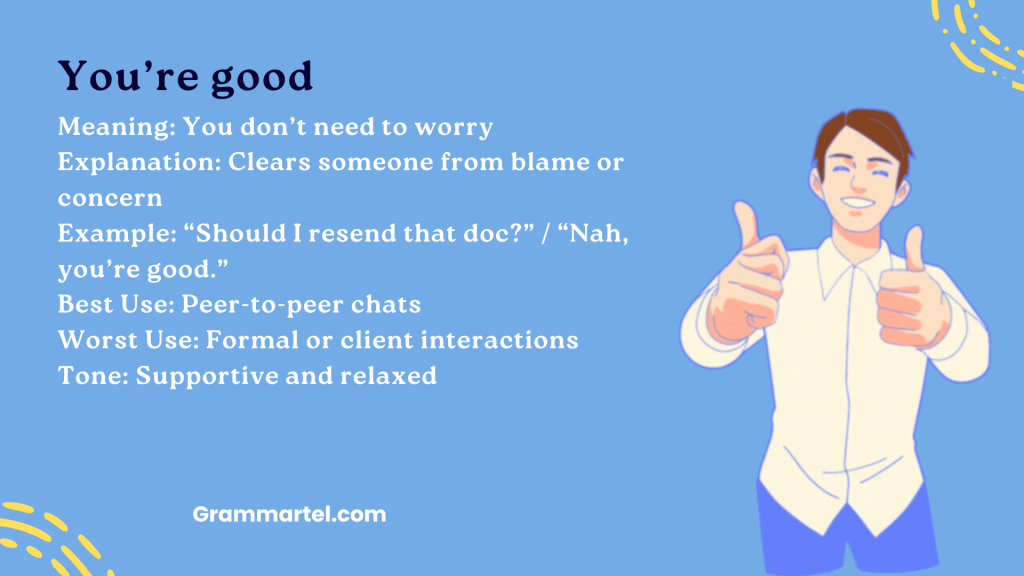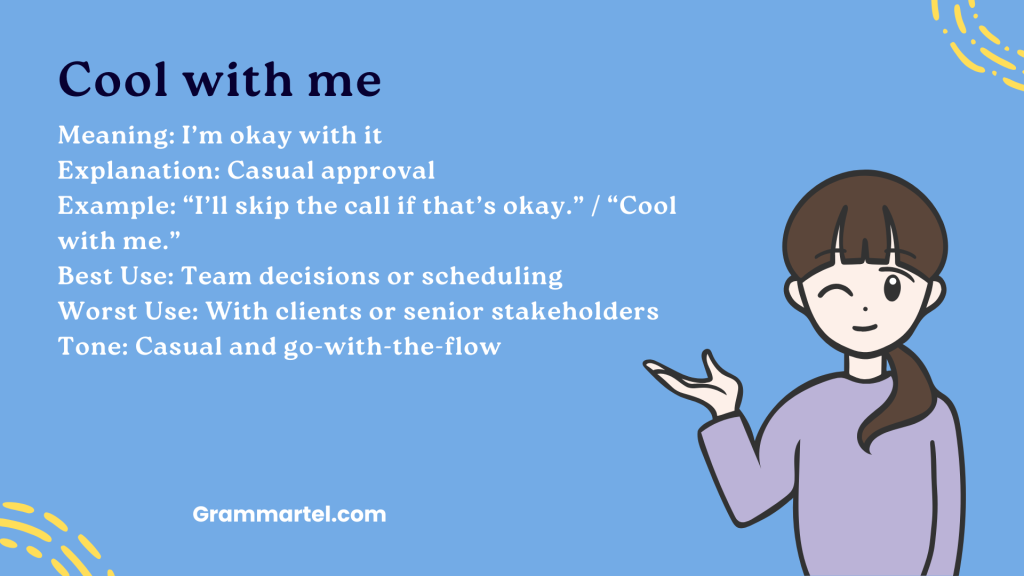We’ve all said “No worries” a hundred times—maybe more. It’s easy, friendly, and works in lots of situations. But sometimes, it doesn’t quite fit the tone—especially in a more formal email or work chat. Other times, you just want to mix things up a bit. Whether you’re talking to your boss, a client, or a friend, having a few other ways to say it can come in handy. From chill replies to more professional ones, here are 40 ways to swap out “No worries” and keep your tone just right.
What Does “No Worries” Mean?
“No worries” is a casual, friendly phrase often used in informal conversations. It originated in Australia but has since gained popularity in many English-speaking countries, including the United States and the UK. At its core, “no worries” is a way of saying, “It’s not a problem,” “Don’t worry about it,” or “You’re welcome.” It’s typically used to reassure someone that everything is fine and that they haven’t caused any inconvenience.
The tone of “no worries” is usually warm, relaxed, and easygoing. It can defuse tension, express kindness, and even help maintain a positive social dynamic, especially in more laid-back settings. Whether responding to an apology or acknowledging thanks, “no worries” offers a light and informal way to convey goodwill.
When to Use “No Worries”
You can use “no worries” in a variety of situations, typically when you’re trying to:
- Reassure someone: If someone apologizes for a minor mistake or delay, saying “no worries” lets them know it’s not a big deal.
- Respond to gratitude: If someone thanks you for a favor or help, replying with “no worries” shows it was no trouble for you.
- Keep the mood casual: In friendly, non-formal settings, it helps maintain a relaxed tone.
- Express that something’s okay: It can be used to let others know there’s no issue with a plan change, small inconvenience, or unexpected event.
However, “no worries” is generally not ideal in formal or professional communication, especially in contexts where a more polished or respectful tone is expected. In such cases, alternatives like “no problem,” “you’re welcome,” or “not at all” may be more appropriate.
40 Casual and Professional Replacements for “No Worries”
1. Not a problem
Meaning: It’s okay, there’s no issue
Explanation: Reassures the other person that their request or concern isn’t troublesome
Example: “Not a problem, I’ll get that report to you by noon.”
Best Use: Replying to a colleague or client request
Worst Use: When someone’s apologizing for a serious error
Tone: Professional and friendly
2. All good
Meaning: Everything is fine
Explanation: A casual way of saying nothing went wrong
Example: “All good, I figured it out.”
Best Use: Casual messages or Slack convos
Worst Use: In formal email threads or client communications
Tone: Chill, casual
3. No problem at all
Meaning: Absolutely no trouble
Explanation: Adds a bit more warmth and emphasis than “not a problem”
Example: “No problem at all—I’m happy to help!”
Best Use: Emails with teammates or friendly clients
Worst Use: When dismissing someone’s serious concern
Tone: Courteous and easygoing
4. Anytime
Meaning: I’m happy to help whenever
Explanation: Suggests openness and willingness for future help
Example: “Thanks for reviewing that!” / “Anytime.”
Best Use: Wrapping up a helpful interaction
Worst Use: When the task was inconvenient or time-consuming
Tone: Warm and open
5. It’s nothing
Meaning: Not a big deal
Explanation: Dismisses the effort as minor
Example: “Thanks for doing that.” / “It’s nothing.”
Best Use: Informal responses to thanks
Worst Use: Can sound too humble or even dismissive in professional settings
Tone: Casual, slightly modest
6. Happy to help
Meaning: I’m glad to assist
Explanation: Friendly and expresses genuine willingness
Example: “Thanks for the quick turnaround.” / “Happy to help!”
Best Use: Customer service, internal team support
Worst Use: When you didn’t actually enjoy helping
Tone: Upbeat and professional
7. Sure thing
Meaning: Absolutely
Explanation: A confident, easygoing “yes”
Example: “Can you send that file over?” / “Sure thing.”
Best Use: Fast-paced, casual settings like Slack or Teams
Worst Use: Formal presentations or high-stakes emails
Tone: Relaxed and casual
8. Of course
Meaning: Naturally, yes
Explanation: Slightly more formal than “sure thing”
Example: “Could you include that data in the update?” / “Of course.”
Best Use: Professional replies that still sound warm
Worst Use: Might sound cold if tone isn’t clear
Tone: Polite and accommodating

9. No trouble at all
Meaning: It wasn’t difficult
Explanation: Reassures that it wasn’t a hassle
Example: “Appreciate you making the edit.” / “No trouble at all.”
Best Use: Responding to thank-yous
Worst Use: Overused in customer service
Tone: Formal and friendly
10. That’s fine
Meaning: It’s acceptable
Explanation: Neutral, gives permission or acceptance
Example: “Sorry I’m running late.” / “That’s fine.”
Best Use: Quick approvals
Worst Use: Can sound passive-aggressive in text
Tone: Neutral to slightly curt
11. No big deal
Meaning: It wasn’t important
Explanation: Downplays the significance of the issue
Example: “Sorry for the mistake.” / “No big deal.”
Best Use: Casual chats with teammates
Worst Use: Minimizing serious problems
Tone: Relaxed and casual
12. You’re welcome
Meaning: I acknowledge your thanks
Explanation: Polite, direct reply to gratitude
Example: “Thanks for helping!” / “You’re welcome.”
Best Use: Standard professional response
Worst Use: When you want to sound more casual or open
Tone: Formal and respectful
13. Don’t mention it
Meaning: No need to thank me
Explanation: Lightly dismissive of the favor
Example: “Thanks for covering my shift.” / “Don’t mention it.”
Best Use: Conversational or modest contexts
Worst Use: Can sound outdated or overly humble
Tone: Casual, humble
Must See: 40 Professional & Creative Replacements for ‘Please Let Me Know What You Think’
14. My pleasure
Meaning: I enjoyed helping
Explanation: Elegant and warm response to gratitude
Example: “Thanks again for your help.” / “My pleasure.”
Best Use: Client communication or customer service
Worst Use: Sarcastic or exaggerated contexts
Tone: Warm and professional
15. Glad to do it
Meaning: I was happy to help
Explanation: Adds a personal, positive touch
Example: “That must’ve been a lot of work.” / “Glad to do it.”
Best Use: Friendly, team-oriented environments
Worst Use: When help wasn’t actually appreciated
Tone: Sincere and friendly
16. It’s all good
Meaning: There’s no problem
Explanation: A reassuring, casual catchall
Example: “Sorry about that mix-up.” / “It’s all good.”
Best Use: Casual group chats or peer-to-peer
Worst Use: Formal reports or emails
Tone: Chill and forgiving
17. That works
Meaning: That’s okay
Explanation: Approves a plan or change
Example: “Can we meet at 2 instead?” / “That works.”
Best Use: Scheduling or logistics convos
Worst Use: Emotionally sensitive exchanges
Tone: Efficient and neutral
18. Fine by me
Meaning: I’m okay with it
Explanation: Indicates agreement
Example: “I’ll send it tomorrow instead.” / “Fine by me.”
Best Use: Informal agreement
Worst Use: When consensus or enthusiasm is needed
Tone: Low-key agreeable

19. I got you
Meaning: I’ll take care of it
Explanation: Supportive and informal
Example: “Can you take notes at the meeting?” / “I got you.”
Best Use: Friendly teams or peer support
Worst Use: Client communication
Tone: Playful and supportive
20. It’s cool
Meaning: It’s okay
Explanation: Dismisses concern or tension
Example: “Sorry I missed that call.” / “It’s cool.”
Best Use: Peer-to-peer, relaxed teams
Worst Use: Formal or executive communication
Tone: Chill and forgiving
21. Absolutely
Meaning: Definitely, for sure
Explanation: Confirms a request or shows full agreement
Example: “Mind reviewing this before the meeting?” / “Absolutely.”
Best Use: Confident replies in meetings or email
Worst Use: When sarcasm might be suspected
Tone: Affirmative and energetic
22. All set
Meaning: Everything is ready or resolved
Explanation: Shows the task or issue has been handled
Example: “Did you update the site?” / “Yep, all set.”
Best Use: Closing the loop on tasks
Worst Use: When more detail is needed
Tone: Casual and efficient
23. I understand
Meaning: I get where you’re coming from
Explanation: Acknowledges someone’s perspective or apology
Example: “Sorry for the confusion.” / “I understand.”
Best Use: Empathetic professional exchanges
Worst Use: When tone could seem detached
Tone: Calm and reassuring
24. You bet
Meaning: Definitely
Explanation: Upbeat and confident yes
Example: “Can I borrow that chart for my deck?” / “You bet!”
Best Use: Friendly work chats
Worst Use: Highly formal settings
Tone: Playful and energetic
25. That’s okay
Meaning: It’s acceptable
Explanation: Neutral way to reassure someone
Example: “Oops, I didn’t hit ‘reply all’.” / “That’s okay.”
Best Use: Letting someone off the hook
Worst Use: Can sound dismissive in text
Tone: Neutral, soft
26. No harm done
Meaning: There’s no damage or issue
Explanation: Light reassurance after a mistake
Example: “Sorry, I mislabeled the file.” / “No harm done.”
Best Use: Small accidents or slip-ups
Worst Use: Serious errors or HR matters
Tone: Forgiving and casual
27. It happens
Meaning: Mistakes are normal
Explanation: Normalizes the situation, reduces pressure
Example: “Sorry I sent the wrong link.” / “It happens.”
Best Use: Consoling a peer or team member
Worst Use: With clients or execs who expect accountability
Tone: Relaxed and empathetic
28. No sweat
Meaning: No effort or trouble
Explanation: Easy-going way to say it wasn’t hard
Example: “Thanks for helping out on short notice.” / “No sweat.”
Best Use: Friendly, casual workplace
Worst Use: Serious situations or formal emails
Tone: Chill and confident

29. You’re good
Meaning: You don’t need to worry
Explanation: Clears someone from blame or concern
Example: “Should I resend that doc?” / “Nah, you’re good.”
Best Use: Peer-to-peer chats
Worst Use: Formal or client interactions
Tone: Supportive and relaxed
30. I’ve got it covered
Meaning: I’m handling it
Explanation: Shows responsibility and initiative
Example: “Need help with the call?” / “I’ve got it covered.”
Best Use: Showing leadership or support
Worst Use: When follow-through is uncertain
Tone: Confident and reliable
Similar Reads: 40 Creative Ways to Say “Join Us” (With Examples)
31. No need to apologize
Meaning: Everything is fine
Explanation: Stops someone from feeling guilty
Example: “Sorry for the delay.” / “No need to apologize.”
Best Use: Soothing a conscientious colleague
Worst Use: When a serious apology is warranted
Tone: Gentle and professional
32. It’s not an issue
Meaning: This isn’t a problem
Explanation: Neutral, direct reassurance
Example: “I missed that deadline.” / “It’s not an issue.”
Best Use: Conflict resolution or customer service
Worst Use: Could sound dismissive if overused
Tone: Calm and composed
33. We’re all good
Meaning: Everything’s settled
Explanation: Friendly, slightly collective way to reassure
Example: “Hope that change didn’t cause problems.” / “We’re all good.”
Best Use: Team chats or casual wrap-ups
Worst Use: Legal or compliance matters
Tone: Friendly and inclusive
34. Fair enough
Meaning: That’s reasonable
Explanation: Accepts someone’s reasoning
Example: “I didn’t join the call because I was on another deadline.” / “Fair enough.”
Best Use: Healthy team discussions
Worst Use: Can sound passive-aggressive if tone’s unclear
Tone: Neutral, sometimes dry
35. No drama
Meaning: Nothing to stress about
Explanation: Super casual way to say it’s fine
Example: “Forgot to CC the team.” / “No drama.”
Best Use: Light-hearted team culture
Worst Use: When someone’s already anxious or upset
Tone: Casual and relaxed
36. We’re good
Meaning: Everything’s fine between us
Explanation: Reaffirms mutual understanding
Example: “Sorry again for that earlier comment.” / “We’re good.”
Best Use: Personal working relationships
Worst Use: Professional reports or conflict resolution
Tone: Personal and casual
37. That’s totally fine
Meaning: It’s 100% acceptable
Explanation: Strong reassurance
Example: “Can I push our call to 3?” / “That’s totally fine.”
Best Use: Flexible scheduling, low-pressure chats
Worst Use: Serious delays or missed deadlines
Tone: Friendly and flexible

38. Cool with me
Meaning: I’m okay with it
Explanation: Casual approval
Example: “I’ll skip the call if that’s okay.” / “Cool with me.”
Best Use: Team decisions or scheduling
Worst Use: With clients or senior stakeholders
Tone: Casual and go-with-the-flow
39. Consider it done
Meaning: I’ll take care of it
Explanation: Confidently commits to action
Example: “Can you revise the draft?” / “Consider it done.”
Best Use: When you want to sound proactive and helpful
Worst Use: When you might miss the deadline
Tone: Bold and efficient
40. No stress
Meaning: Don’t worry about it
Explanation: Aims to reduce anxiety
Example: “Hope the delay didn’t throw things off.” / “No stress.”
Best Use: Peer reassurance
Worst Use: When real stress is involved
Tone: Easygoing and empathetic
Conclusion
Saying “No worries” is fine, but using it every time can start to sound a bit flat. The good news? You’ve got plenty of other options—some more casual, others a little more polished. Choosing the right one can make your messages sound more thoughtful and natural. Try a few, mix them up, and find the ones that feel like you. It’s all about sounding clear, kind, and human. Grammartel: Your Pathway to Writing Mastery.

